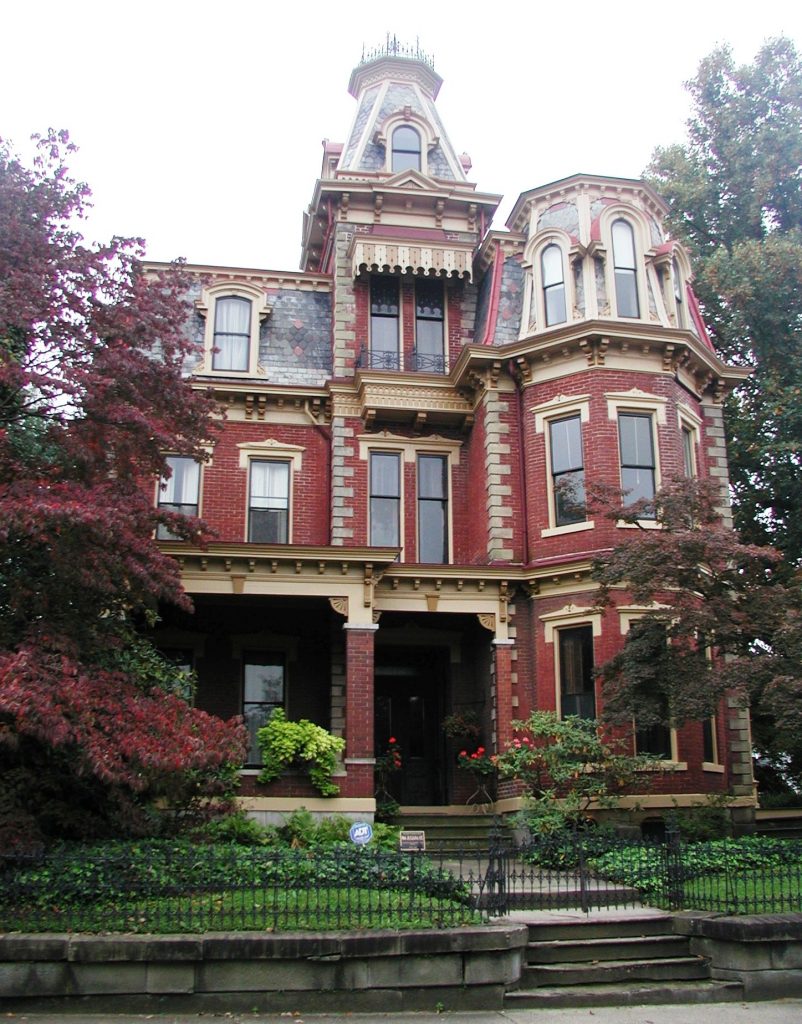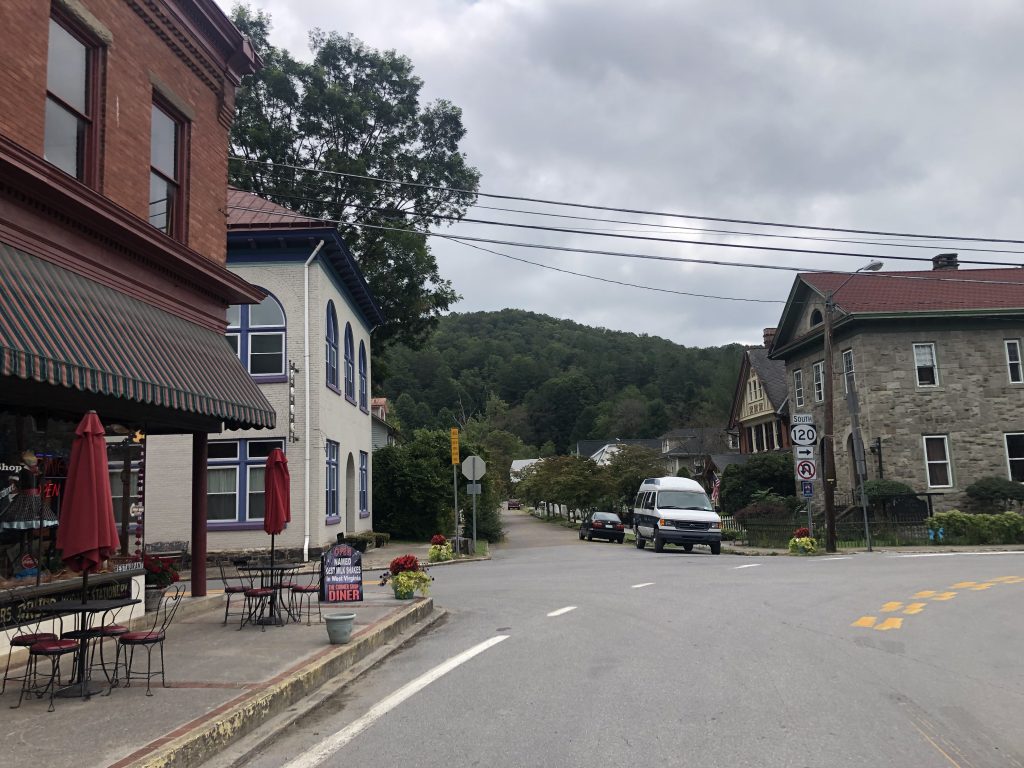This is the first in a series of pieces about architecture in the Appalachian Region. Have a building or style you think is unique to the region? Contact Nick Musgrave at nick@expatalachians.com.
The archetype for Appalachian architecture may be the mountain cabin, but the region is rich with structures of every major American building style. Rustic early dwellings, Victorian residences, and modern skyscrapers all contribute to the built environment. Instead of having a dominant architectural style, much of Appalachia borrows from the aesthetics of surrounding regions, like the Northeastern feel of Pittsburgh’s rowhouses or the Southern charm of Lexington, VA.
There are trends, however, that can be found in pockets of place and time. The Gilded Age mansions of West Virginia are one of these cases.
After the Civil War, the Mountain State experienced a significant economic boom as railroads opened up the state’s natural resources to eastern ports and transportation networks. The Baltimore and Ohio Railroad reached the Ohio River at Wheeling in 1853 and established a more direct route through Parkersburg by 1857. Oil was discovered in the Parkersburg region at the onset of the war, and by the end of that decade, the city had its first refinery. The oil and gas industry was the prototype for the state’s extraction-based economy. Parkersburg quickly grew into one of the largest and most influential cities in the new state, with many of its prominent citizens serving as West Virginia’s first governors and senators.
That growth in power and purse can still be seen today in the city’s primary historic district, Julia – Ann Square. Abutting the central business district, the neighborhood was home to Senator Peter Goodwin Van Winkle, Governor William E. Stevenson, and Joseph Diss Debar, the creator of West Virginia’s State Seal. The homes reflect the newfound wealth that flowed out of the ground, showcasing the stylish architectural trends of their eras: Queen Anne, Second Empire, and Colonial Revival.

Perhaps the most stunning house is the William Nelson Chancellor House at 904 Juliana Street. Chancellor was a successful oil investor and banker, the wealth of which financed his grand home in 1878. The Second Empire house boasts a mansard roof and a four-story tower, the interior illuminated by 72 windows. It remains a private residence and is owned by Chancellor’s great-great-granddaughter, Katharine Brown.
“It’s pretty special,” Brown said. “There aren’t many houses in the U.S. that have been passed down for five generations.”
Chancellor was also a prominent real estate developer in the town’s early boom. He erected the city’s two largest downtown hotels, one of which is still in operation. According to Brown, he preferred to build new structures at major intersections and was known as “Corner Lot Chancellor.” His hotel and his home remain two of Parkersburg’s most significant Victorian buildings.
While many of the grand houses in Parkersburg have fallen into disrepair over the decades, Brown and her husband have endeavored to keep the family home in prime condition. They do much of the work themselves, including restoring 46 of the house’s original windows. They did, however, hire an outside firm to replace the roof.
Brown and her neighbors have organized to improve their neighborhood, and encourage visitors and new residents. The Julia-Ann Square Historical Community Association is a nonprofit that has erected archways at the neighborhood’s entrances, helped fund sidewalk improvements, and holds events throughout the year to raise money and awareness.

“I can’t say enough good things about our neighborhood association,”Brown said. “We hope to encourage more people to raise their families in Julia-Ann Square. You can own a great property at an affordable price…if you’re willing to give up cookie-cutter homes.”
In fact, there is a movement of young people who have eschewed the suburbanization of their parents’ generation for historic homes in city centers. Online resources such as Cheap Old Houses have developed a wide following by showcasing historic homes on the market. The state of West Virginia sweetened the deal for these types of houses with the passage of new tax credits in 2017 for renovations on historic buildings. Under the recent expansion, structures renovated for use as an owner-occupied residence receive a 20 percent credit, while commercial ventures receive a 25 percent credit, which can be added to the 20 percent federal credit on revenue-producing properties.
“A lot of people ask if they have to use the residential tax credit if the building was originally built as a house,” said Betsy Sweeny, Director of Heritage Programming at Wheeling Heritage. “As long as they’re converting the property for commercial use, they can claim the State and Federal commercial credits.”
Both the state and federal tax credits are administered through the WV State Historic Preservation Office (SHPO). While the residential credits are a plus, the combined commercial credits have been a boon for historic preservation in the state. Wheeling, Charleston, and Huntington have all seen major investments in downtown buildings being converted into upscale apartments, with more projects in the pipeline.
To qualify for the tax credits, the building must be a certified historic structure on the National Register of Historic Places or in a recognized historic district. Julia-Ann Square has been a registered district since 1977.

West Virginia’s historic homes are a tourist attraction as much as an asset for future development. A prime example of this is the town of Bramwell, near the southern tip of the state. Known as the “Home of the Millionaires,” Bramwell was home to at least 22 millionaires over the early 20th century. Most of the town’s wealth was made in the Pocahontas Coal Field. The first coal from the field was mined a few miles across the Virginia border and the boom in coal production quickly enveloped Mercer and McDowell Counties. Successful early coal operators made Bramwell their home, making it the wealthiest community per capita in the United States and leaving their mark on the town’s landscape.
Like Parkersburg’s oil industry, the Pocahontas Coal Field was opened up by the expansion of railways into the mountains. The Norfolk and Western dug its way deep into southern West Virginia, exporting millions of tons of coal to the Virginia port. Bramwell became an early social and economic center of the Pocahontas Field, with many of the area’s first coal operators calling the town home. They included Edward Cooper, Sr., whose father, John Cooper, had opened the first mine on the West Virginia side of the field. Edward’s first home was damaged in a 1910 fire that decimated the town, but he rebuilt with grandeur.
The 1910 Edward Cooper House was built in a Queen Anne style and boasts brick imported from England. The home dominates the residential side of Main Street, with an unmistakable green roof that is one of the first residential copper roofs in the United States. The house is the eastern anchor of the “Cooper Compound,” which includes a separate building housing an indoor pool and another home built for Cooper’s son, Edward Jr. The house symbolized the power of Edward Sr., who in addition to his business success was a prominent community leader, representing southern West Virginia in Congress from 1915 to 1919.
Like the Chancellor house in Parkersburg, the Cooper House is still owned by a descendent of Edward Cooper, Sr. Kelly Goins is the fourth generation family member to own the home, and her daughter is the fifth to live in it.
“It’s home,” Goins said. “I grew up here, I love it. I’m the only descendent who still owns their family’s home in Bramwell.”

While not representative of all of West Virginia’s Gilded Age mansions, both houses were built by men whose wealth was created in the state’s extraction industries, and each has been lovingly cared for by the descendants of their initial owners. Katharine Brown even found a check from the Bank of Bramwell in the basement of the Chancellor House.
The Bank of Bramwell, like the Cooper House, is a symbol of the town’s heyday. The bank was one of the richest in the nation for its size and financed projects outside of the region, including a country club in Washington, D.C. The bank was unfortunately a bellwether for the town’s decline as well as its prosperity, going into a liquidation plan in 1933 as a result of the Great Depression. The wealthy businessmen and bankers who fueled Bramwell’s growth also saw their fortunes fall during the 1930s, and many left the town afterward.
“It was an immediate decline after 1929,” Bramwell Mayor Louise Stoker said.
Today, Bramwell is a pleasant hamlet of around 350 residents. A replica train station at the end of Main Street houses a museum and visitor’s center for the Coal Heritage Trail, one of two tourist trails that pass through town. The other is the Pocahontas Trail, part of the Hatfield & McCoy network of ATV trails that snake through southern West Virginia.
The grand old homes in Bramwell are no longer inhabited by captains of industry. The nearest coal mine operator is headquartered in Luxembourg, and the white-collar jobs that catered to the regional elite left with their clients. Despite this, however, there is very little vacancy in the town; some residents commute to Princeton or Bluefield, while many of the homes have been purchased for use as vacation homes or B&Bs, catering to the ATV network.

Many of West Virginia’s cities saw their peak in the first half of the 20th century. As a result, many of their historic homes and districts have been spared the wrecking ball of progress and remain standing. While perceived by some as a reminder of the state’s stagnant growth, others see them as an asset for the future. The movement of young people looking for “cheap old houses” can find affordable homes with plenty of historic charm in West Virginia.
In addition to her professional role with Wheeling Heritage, Betsy Sweeney is renovating a historic home of her own. Following her journey on her blog, it is clear that undertaking such a project is difficult—but immensely rewarding.
“It sounds cliché, but they really don’t build homes like they used to,” Sweeney said. “The timbers were usually made from strong, old-growth trees. The bones are incredibly strong, and you can’t replicate that with modern materials.”
One of the prime benefits of many of these homes is their location. With communities carved between waterways and hills, many of West Virginia’s towns are surprisingly dense and walkable for a state with such a rural reputation. Katharine Brown remembers her own childhood in Julia-Ann Square fondly and hopes that others are able to grow up with the same amenities.
“I walked down the street to attend school at Nash, and in the other direction I could reach the Carnegie Library on foot,” Brown said. “There was, and is, a great sense of community that you just don’t get when you’re dependent on a car and mall for commercial life.”
West Virginia’s historic homes offer a combination of value and charm that is hard to find elsewhere. Coupled with the state’s low cost of living and the allure of historic tax credits, there is a lot of opportunity in the Mount State’s mansions.
Subscribe to The Patch, our newsletter, to stay up-to-date with new expatalachians articles and news from around Appalachia.
Nick Musgrave first became fascinated with West Virginia’s history while growing up in Parkersburg. He continues to read, research and write on the Mountain State’s past from its birthplace in Wheeling. For more neat history and some political snark, follow him on Twitter: @NickMusgraveWV.


